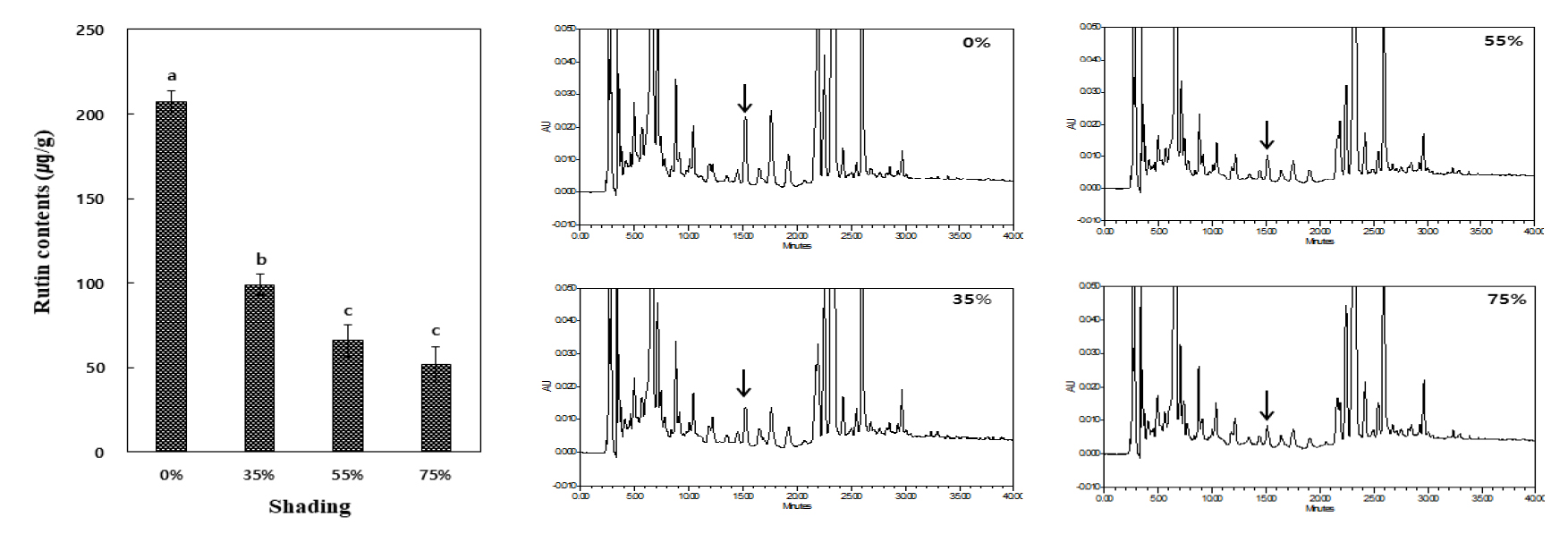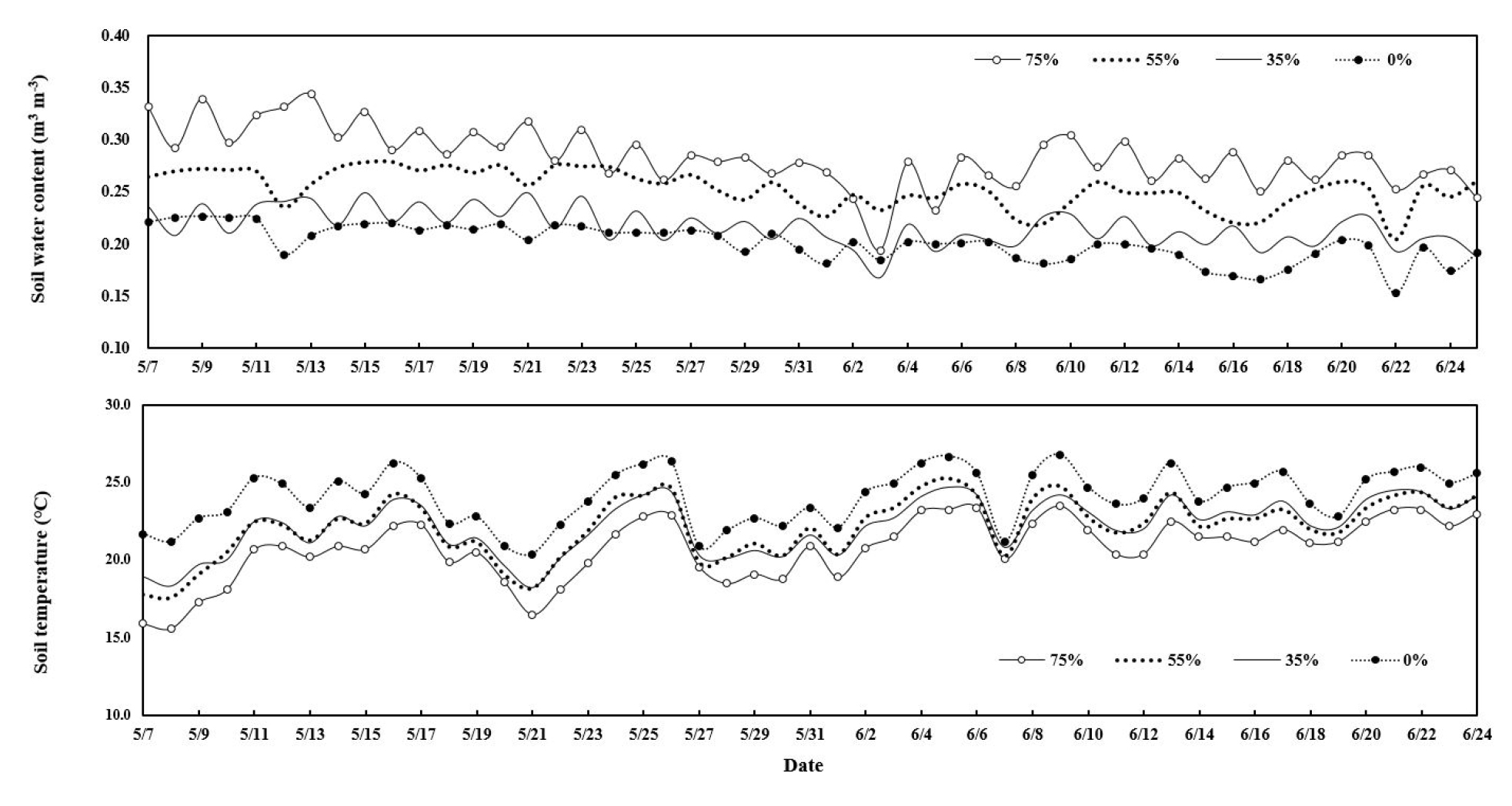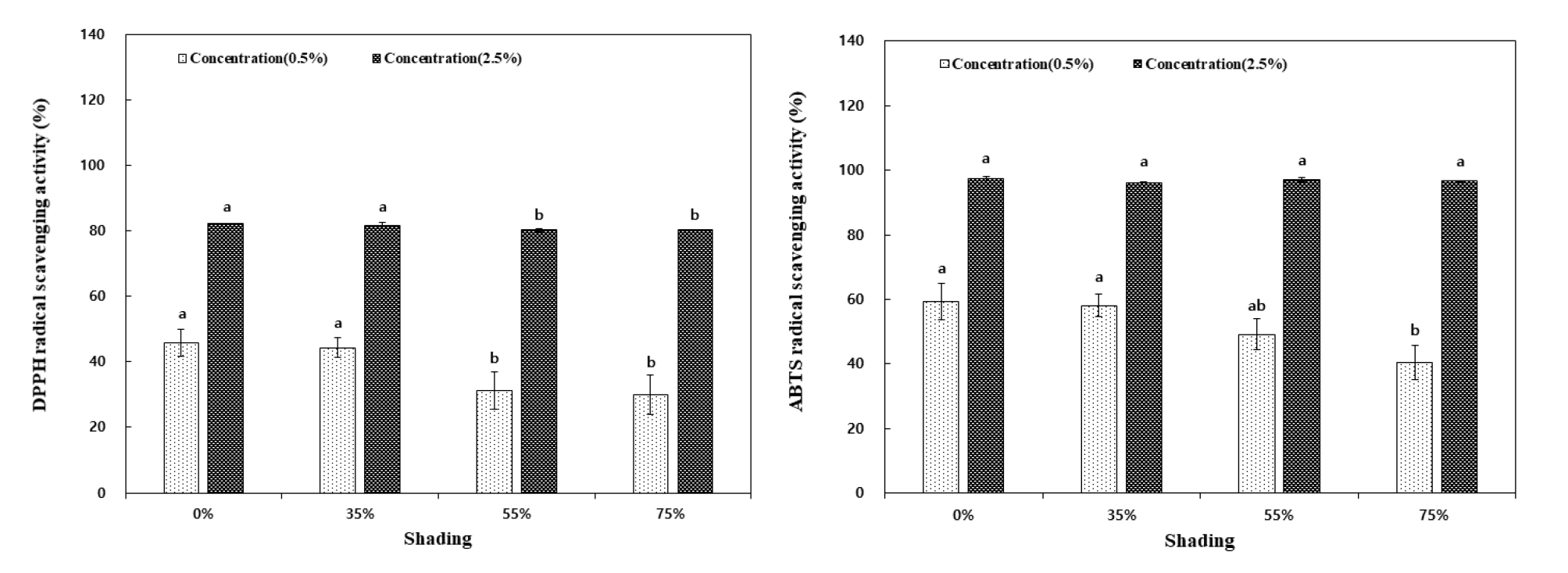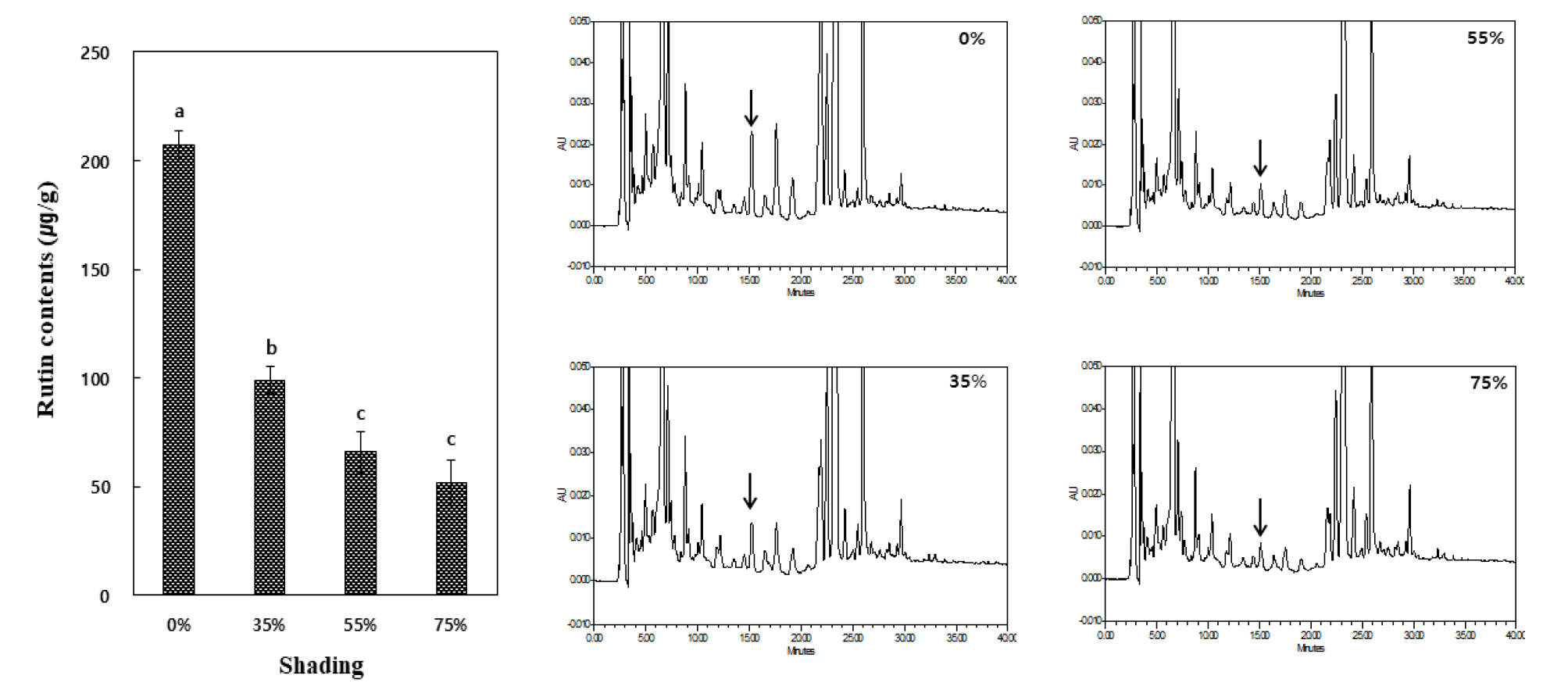Introduction
급격한 경제성장에 따른 산업화 및 도시화와 더불어 우리 식문화의 서구화, 운동부족 및 불규칙한 식습관 등이 점점 심화되어 비만, 심혈관계 질환, 당뇨, 만성염증 등의 생활 습관적 질병이 날로 증가하고 있는 추세이다 (Liu, 2003). 이러한 현상들로 인해 항산화, 항노화 및 항암 등의 성분을 지닌 천연식품에 대한 사람들의 관심은 나날이 커지고 있다.
명월초 (Gynura procumbens)는 남부아시아, 인도네시아와 태국, 말레이시아가 원산지인 국화과의 식물로 말레이시아에서는‘sambungnyawa’라 불리우고, 중국에서는‘bai bing ca’로 알려져 있으며, 주로 주식인 밥과 함께 쌈으로 즐겨 먹었는데 (Rosidah et al., 2008), 동남아시아에서 건강기능 식품 및 약용으로 이용되는 식물이다 (perry, 1980). 명월초의 기능성이 알려지면서 수요가 증가하고 있으나, 묘목 가격이 비싸고 재배방법이 표준화되어 있지 않아 관련연구가 시급하다.
수경재배는 토양 없이 일정한 영양분을 공급하여 작물을 생산하는 시스템으로, 일정 규모 시설 내에서 안정수확이 가능하고 연작장해 없이 균일하게 작물을 생산 할 수 있다는 특징이 있다. 수경재배 시 품질 향상을 위한 특수물질 처리에 관한 연구는 대내외적으로 활발히 진행되고 있고, 그 효과에 관한 결과도 많이 보고되고 있다 (Mizrahi and Pasternak, 1985; Adams and Grimmett, 1986; Ehert and Ho, 1986; Kim, 1992; Mizrahi et al., 1994). 그러나 대부분의 방법들은 과실 내 성분이나 조직, 세포 등에 스트레스를 줌으로써 과실 수나 무게의 감소를 초래하거나 저장성이 짧아지는 등의 문제점으로 인하여 실용화시키기가 어려웠다. 이를 보완하고자, 생육과 수량의 감소를 최소화하면서 품질 향상, 병해 저항성 등을 증대시키고자 다양한 연구가 보고 되었다 (Pasternak et al., 1986; Carver et al., 1987; Kim, 1992; Lee et al., 1993; Cherif et al., 1994; Lee, 2000).
수경재배에서 과실의 당도와 더불어 다른 품질들을 개선하고자 적용되는 재배방법은 관수조절, 양액의 총 이온 농도조절, 광조절 (Martin et al., 1970; Cho and Chung, 1997; Nishitani, 2004; Woo and Kang, 2006) 등이 있다. 또한, 토마토 양액재배에서 급양액의 억제 방법은 양분공급이 감소되어 생육이 억제되고, 수량도 감소된다는 보고 (Aljibury and may, 1970)가 있다.
본 연구는 노지재배의 단점을 보완할 수 있는 수경재배 기술의 일환으로 유기농자재로 등록된 액비를 이용하여 반음지식물인 명월초의 수경재배 시 차광정도에 따른 생육 및 기능성 성분 함량을 측정하여 명월초 상품성 향상을 위한 최적의 재배조건을 구명하고자 수행하였다.
Materials and Methods
시험처리 본 실험은 충청북도농업기술원 유기농업연구소 시험연구포장에서 수행하였으며, 시험에 사용된 명월초 (Gynura procumbens)는 청주시 미래 영농조합법인에서 구입하여 사용하였다. 명월초는 삽목 30일 후 생육이 우수한 묘를 선발하여 30 × 30 cm로 2019년 4월 24일 정식하였다. 차광처리는 무처리, 흑색차광 35%, 흑색차광 55%, 흑색차광 75%로 전 생육기간에 걸쳐 차광하였다. 수경재배 방식은 비순환식 고형배지경 방식을 사용하였고, 배지조성은 수경재배 시 명월초 생육이 우수한 버미큘라이트를 사용하였다 (Lee et al., 2019). 실험에 사용한 양액은 생육증진용 유기농자재로 등록된 시판자재 34종을 성분 분석한 후 2종 (Animal byproduct 75% + Seaweed extract 25%, Seaweed extract 100%)을 혼합하여 사용하였으며, 사용된 액비의 화학성은 Table 1과 같다. 액비의 처리 농도는 액비 중 질소농도를 10 mg L-1로 조절하였으며, Kim et al. (2007)의 방법을 참고하여 pH 6.0 - 7.0, EC 1.0 - 2.0 dS m-1로 명월초 정식부터 재배가 끝날 때까지 1일 1회, 회 당 100 L씩 점적관수 (Ø13 mm, Nam Kyung Co.)를 이용하여 처리하였다. 액비로부터 공급된 처리구의 질소 양은 20 kg N 10a-1 이었다. 시험구 배치는 완전임의배치법 3반복이며 처리당 면적은 7.2 m2 이다.
Table 1.
Chemical properties of mixed organic agricultural materials used in this experiment.
| T-N | P2O5 | K2O | CaO | MgO | Na2O | |
| - % - | ||||||
| Range† | 4.12 - 7.29 | 1.43 - 3.15 | 4.41 - 7.08 | 0.14 - 0.41 | 0.25 - 0.45 | 1.35 - 3.12 |
| Average‡ | 5.84 ± | 1.97 ± | 5.02 ± | 0.33 ± | 0.41 ± | 2.57 ± |
‡Average : represents the average values obtained by measuring 10 samples.
광량 및 근권 환경 측정 차광정도별 조도 및 광합성광량자속밀도 (PPFD, Photosynthetic Photon Flux Density)는 Handheld Spectrometer PG200N (UPRtek, Taiwan)를 사용하여 차광망 하부에서 5월 23일 1시에 지면과 수평으로 10반복씩 측정하였고, 근권 온도 및 토양수분 함량은 5TE (Decagon, USA) 센서를 사용하여 지상부에서 15 cm 밑의 근권 부분을 명월초 정식 후 5월 - 6월까지 측정하였다.
엽색 및 엽록소 함량 측정 엽색은 색차계 (CM-5, Minolta, Japan)을 이용하여 잎 윗부분의 엽맥을 피해서 Hunter값 (L, a, b)을 측정하였다. 엽록소 함량은 각 처리별로 2매씩 엽을 채취한 후, 엽의 중앙과 좌, 우에서 0.1 g 엽편을 채취하였다. 10 mL의 DMSO (dimethyl sulfoxide) 용액이 들어 있는 유리병에 넣어 60°C로 설정된 항온기에서 6시간 색소를 추출하였다 (Hiscox and Israelstam, 1979). 추출한 용액은 UV-Visible Spectrophotometer (Cary 300, Agilent, USA)를 이용하여 663 nm와 645 nm의 파장에서 흡광도를 측정하고, Arnon (1949)의 방법에 따라서 엽중량 당 엽록소 함량을 산출하였다.
생육조사 생육조사 중 초장 및 줄기 직경, 근장, 근중은 시험 종료시점에 각 시험구별로 10주를 측정하여 평균하였고, 명월초의 수량은 7일 마다 수확하여 누적생산량을 통해 계산하였다. 명월초 상품성을 나타내는 엽장, 엽폭, 엽중, 엽두께는 주당 가장 큰 엽을 조사하였다. 기타 명월초 생육 조사는 농업과학기술 연구조사 분석기준 (RDA, 2012)에 준하였다.
ABTS 라디칼 소거활성 ABTS 라디칼 소거 활성 능력은 Van den Berg et al. (1999)의 방법을 참고로 하여 측정하였다. ABTS solution은 2,2'-Azinobis (3-ethylbenzothiazoline-6-sulfonic acid) diammonium salt와 potassium persulfate를 혼합한 후 24시간 ABTS radical을 형성시킨 다음 증류수를 이용하여 734 nm에서 흡광도 값이 1.00이 되도록 희석하였다. 각 농도 별 추출물에 ABTS solution을 첨가한 다음 37°C에서 20분 동안 반응시켜 UV-Visible Spectrophotometer (Cary 300, Agilent, USA)를 사용하여 734 nm에서 흡광도를 측정하였으며, ABTS 라디칼 소거활성은 Eq. 1에 따라 계산하였다.
‘ASample’ = Absorbance values of ABTS radicals after treatment with sample.
‘ABlank’ = Absorbance values of H2O.
‘AControl’ = Absorbance values of ABTS radicals.
DPPH 라디칼 소거활성 1,1-diphenyl-2-picryl-hydrazyl (DPPH)를 이용한 전자 공여능은 Bondet et al. (1997)의 방법을 참고로 하여 측정하였다. DPPH solution은 DPPH를 515 nm에서 흡광도 값이 1.00이 되도록 에탄올로 희석하였다. 각 농도 별 추출물에 DPPH solution을 첨가한 다음 37°C에서 20분 반응시켜 UV-Visible Spectrophotometer (Cary 300, Agilent, USA)를 이용하여 515 nm에서 흡광도를 측정하였으며, DPPH 라디칼 소거활성은 Eq. 2에 따라 계산하였다.
| $$\mathrm{DPPH}\;\mathrm{radical}\;\mathrm{scavenging}\;\mathrm{activity}(\%)=\lbrack1‒({\mathrm A}_{Sample}‒{\mathrm A}_{Blank})/{\mathrm A}_{Control}\rbrack\times100$$ | (Eq.2) |
‘ASample’ = Absorbance values of DPPH radicals after treatment with sample.
‘ABlank’ = Absorbance values of ethanol.
‘AControl’ = Absorbance values of DPPH radicals.
총 페놀 함량 분석 총 페놀 함량은 Folin-Denis (AOAC, 1995)의 방법을 참고로 하여 측정하였다. 건조시료 1 g에 1% Acetic acid/diethyl ether 100 mL를 혼합하여 5분간 추출한 다음 상등액을 제거 하였다. 잔여물과 70% Acetone을 혼합하여 50 mL를 만든 다음 2시간 동안 교반 추출하였다. 상등액을 filter paper로 걸러낸 다음, 70% Acetone으로 50 mL 정용 하였다. 추출물 50 µL와 증류수 950 µL, Folin 500 µL를 혼합한 다음, 20% Sodium carbonate 2.5 mL 넣고 40분 동안 실온에서 반응시켰다. 반응물을 흔들지 않은 상태에서 맑은 액체를 UV-Visible Spectrophotometer (Cary 300, Agilent, USA)를 사용하여 725 nm에서 흡광도를 측정하였다. Standard는 Tannic acid으로 정량 직선방정식을 사용하였다.
총플라보노이드 함량 분석 추출물 500 µL, 증류수 500 µL와 10% aluminum nitrate 1mL를 차례로 가한 다음 혼합하고 상온에서 30분간 반응시켰다. 그 후 UV-Visible Spectrophotometer (Cary 300, Agilent, USA)를 이용하여 420 nm에서 흡광도를 측정하였다. Standard는 Rutin hydrate로 정량 직선 방정식을 사용하였다.
VitaminC함량 분석 비타민 C 함량은 Jagot and Dani (1982)의 방법을 참고로 하여 측정하였다. 건조시료 0.5 g에 증류수 10 mL 넣은 다음, 4,500 rpm에서 20분 동안 원심 분리하여 추출하였다. 추출물을 filter paper (No.2)로 걸러낸 다음, 200 µL와 trichloroacetic acid (TCA) 800 µL를 넣고 3,000 rpm으로 5분 동안 원심 분리하였다. 상등액 500 µL와 증류수 1.5 mL, Folin 200 µL를 넣고 혼합한 다음 10분간 상온에서 반등시킨 후, UV-Visible Spectrophotometer (Cary 300, Agilent, USA)를 사용하여 760 nm에서 흡광도를 측정하였다. Standard는 Ascorbic acid로 정량 직선 방정식을 사용하였다.
HPLC분석에 의한 Rutin hydrate 함량 측정 Rutin의 함량 측정은 High performance liquid chromatography (HPLC) 분석은 Waters 2695 system (Waters, Milford, MA, USA)과 Waters 2996 Photodiode array detector (PDA)를 통해 분석하였다. 실험에 사용된 표준물질은 1 mg을 취하여 1 mL의 메탄올에 용해하여 사용하였다. 표준물질과 시료는 0.45 µm membrane filter (Waters, Milford, MA, USA)를 이용해 여과 하였고, 표준물질 10 µL 시료 20 µL를 A: acetonitile, B: 1% acetic acid/H2O을 이동상으로 Waters XBridge™ C-18 column (4.6 mm × 250 mm) packed with 5.0 µm diameter particles (Waters, Milford, MA, USA)를 이용하여 흡광도 255 nm에서 분석하였다.
통계분석 처리 간 통계분석은 SPSS 23.0 프로그램을 이용하였으며, Duncan’s multiple range test를 통해 각 처리간의 통계적 유의성을 비교 검토하였다.
Results and Discussion
광량 및 근권 환경 차광정도에 따라 조도 및 광합성광량자속밀도 (PPFD, Photosynthetic Photon Flux Density)가 차이를 나타내었으며, 차광처리별 조도는 Table 2와 같으며, 광합성광량자속밀도는 단위면적당 광합성에 필요한 광양자량을 나타내는 지표로 Table 3과 같다. 무차광시 조도가 69,944 lux로 가장 높았으며, 35% 흑색차광시 조도는 36,164 lux로 무차광의 52% 수준을 나타내었으며, 55% 흑색차광시 조도는 29,248 lux로 무차광의 42% 수준, 75% 흑색차광시 조도는 24,813 lux로 무차광의 35% 수준의 조도를 나타내었다. 작물의 광합성에 중요한 역할을 하는 400 - 700 nm 사이의 PPFD값도 차광처리별 조도와 비슷한 경향을 나타내었으며, 차광정도가 높을수록 PPFD도 감소하였다. 차광정도별 380 - 400 nm의 PFD-UV값과 700 - 780 nm의 PFD-FR 값은 400 - 700 nm 사이의 PPFD값에 비해 차광처리 간에 차이가 적은 경향을 나타내었다. 이러한 결과는 Park et al. (2016)이 보고한 결과와 같은 경향을 나타내었다. 명월초 정식 후 차광정도에 따른 5월 - 6월 중순까지의 근권 온도 및 토양수분 함량은 Fig. 1과 같다. 75% 흑색차광 시 근권 토양수분 함량이 가장 높게 나타났으며, 흑색차광 55%, 흑색차광 35% 순으로 낮아졌으며, 무처리가 가장 낮게 나타났다. 근권의 온도는 무처리가 가장 높게 나타났으며, 흑색차광 35%, 흑색차광 55% 는 유사하게, 흑색차광 75% 가 가장 낮게 나타났다. 따라서, 차광정도에 따른 근권 토양수분 함량과 온도를 비교해 보면 차광정도가 클수록 근권의 토양수분 함량이 높게 나타났으며, 근권의 온도는 낮은 경향을 나타내었으며, 차광정도가 낮을수록 근권의 토양수분 함량이 낮고, 근권의 온도가 높은 경향을 나타내었다.
Table 2.
Light intensity under different shading levels.
| Treatments | 0% | 35% | 55% | 75% |
| Light intensity (lux) | 69,944 ± 251 | 36,164 ± 317 | 29,248 ± 213 | 24,813 ± 189 |
Table 3.
PPFD under different shading levels.
엽색및엽록소함량 차광정도에 의한 명월초의 엽색은 Table 4와 같다. 밝기를 나타내는 L 값은 35% 흑색차광처리에서 6.4 로 가장 높게 나타났으며, 75% 흑색차광처리에서 5.2로 가장 낮게 나타났다. 붉은색을 나타내는 a 값은 75% 흑색차광처리에서 0.6 으로 가장 높게 나타났으며, 35% 흑색차광처리에서 -0.1로 가장 낮게 나타났다. 노란색을 나타내는 b 값은 처리 간에 유의성 있는 차이가 나타나지 않았다. 차광정도에 따른 명월초의 엽록소 함량은 Table 5와 같다. 엽록소 a 함량은 무처리에서 1.7 mg g-1으로 다른 차광처리 비해 낮게 나타났으며, 엽록소 b 함량은 처리 간에 차이가 나타나지 않았다. 전체 엽록소 함량은 무처리에서 2.3 mg g-1로 다른 차광처리에 비해 낮게 나타났다. 내음성 수종들은 내음성이 약한 수종에 비하여 더 깊은 음지에서 제한된 빛을 이용한 광합성 수행능력을 갖기 위하여 형태학적이나 생리학적으로 다른 특성차이를 가지며, 이렇게 낮은 광도에 순화된 내음성 식물들은 강한광에 노출되었을 때 쉽게 피해를 받는다 (Valladares et al., 2000). 내음성이 강한 죽절초는 자연광조건에서 생장하였을 때 엽록소 함량 및 광합성율이 감소하였다는 보고 (Je et al., 2006)와 같이 반음지성 식물인 명월초도 무차광 처리에서 다른 처리에 비해 엽록소 a와 총엽록소 함량이 낮게 나타났다.
Table 4.
Leaf color of Gynura procumbens under different shading levels.
| Shading | Leaf color (Hunter value) | ||
| L | a | b | |
| 0% | 6.0b† | 0.0b | 5.1a |
| 35% | 6.4a | -0.1c | 5.0a |
| 55% | 6.0b | 0.1b | 4.8a |
| 75% | 5.2c | 0.6a | 4.8a |
a: The value of redness to greenness of color, -80 (green) - 80 (red).
b: The value of yellowness to blueness of color, -80 (blue) - 80 (yellow).
†Numbers with the same letter within a column are not significantly differed (Duncan’s test, p < 0.05).
Table 5.
Chlorophyll contents of Gynura procumbens under different shading levels.
| Shading | Chlorophyll contents (mg g-1) | ||
| a | b | Total | |
| 0% | 1.7b† | 0.6a | 2.3b |
| 35% | 2.1a | 0.6a | 2.7a |
| 55% | 2.2a | 0.6a | 2.8a |
| 75% | 2.3a | 0.6a | 2.9a |
생육특성 차광정도에 따른 명월초의 생육은 Table 6와 같다. 초장은 75% 흑색차광 에서 159.5 cm로 가장 크게 나타났으며, 무차광 처리에서 93 cm로 가장 작게 나타나 차광정도가 클수록 초장이 큰 경향을 나타내었다. 이러한 결과는 차광은 식물체의 줄기 신장에 영향을 준다고 알려져 있는데, 잔대에서는 차광율이 높을수록 초장이 늘어난다고 보고 (Moon and Pyo, 1981)와 같은 결과를 나타내었다. 경경은 무차광 처리에 비해 차광처리에서 크게 나타났으며, 흑색차광 35%, 55%, 75%간 에는 유의성 있는 차이가 나타나지 않았다. 근장과 근중은 흑색차광 75% 처리에서 67 cm, 11.5 g으로 가장 작게 조사되었으며, 이러한 결과는 차광율이 높아질수록 뿌리의 생장이 저조한 것은 뿌리로 분배되는 광합성산물의 비율이 상대적으로 낮아졌기 때문이라는 (Kim et al., 2010)의 보고와 유사한 경향을 나타내었다. 또한, 식물의 뿌리생장도 각기 적정한 차광이 다르며, 차광을 통한 광조절은 뿌리의 좋은 생육을 위해서는 필수 요건이라고 보고하였다 (Jeon et al., 2015). 차광정도에 따른 명월초의 수량은 무차광 처리에 비해 차광처리에서 높은 경향을 나타내었으며, 흑색차광 35%, 55%, 75%간 에는 유의성 있는 차이가 나타나지 않았다. Hwang et al. (1995)은 천궁의 생육 및 수량에 있어서 차광 및 비닐 피복에 의한 차광이 높을수록 광합성 작용에 영향을 주어 식물체가 연약하게 생장한다고 보고하였는데, 본 실험에서는 차광을 한 처리구에서 무차광 처리에 비해 오히려 좋은 생육을 나타내었다. 작물 재배 시 차광은 광도, 기온 및 지온을 저하시켜 식물의 생육, 수확량 및 엽록소 함량 등에 영향을 미치며 수광에 필요한 식물의 엽면적을 증가시키는 역할을 한다 (Seo et al., 1994; Brand, 1997). 그러나 지나친 차광은 광합성의 감소를 초래하여 식물의 생육을 저하시킬 수 있으며, 특히, 양지성 식물에 지나친 차광처리는 광 부족현상을 일으켜 식물생육에 악영향을 미칠 수 있다 (Son and Chae, 2003)고 보고하였다. 따라서, 식물마다 요구되는 광도가 다르기 때문에 식물체에 적합한 차광율에 대한 구명이 필요하며, 명월초는 35%와 55% 흑색차광이 생육에 가장 적합한 것으로 판단되었다. 차광정도에 따른 명월초의 엽 상품성 중 엽장, 엽폭, 엽중은 흑색차광 35%와 55%에서 각각 15.9 cm, 16.3 cm, 7.4 cm, 7.8 cm, 5.56 g, 5.78 g으로 가장 높게 나타났으며 (Table 7), 이처럼 35%와 55% 흑색차광에서 생육이 왕성한 것은 차광으로 명월초의 생육에 적합한 광량이 투과되었기 때문이라고 생각된다 (Park et al., 2004; Lee et. al., 2012; Jeon et al., 2015). 엽두께는 처리 간에 유의성 있는 차이가 나타나지 않았다.
Table 6.
Growth of Gynura procumbens under different shading levels.
Table 7.
Leaf marketability of Gynura procumbens under different shading levels.
항산화 활성 및 기능성성분 함량 차광정도에 따른 명월초의 항산화활성 Fig. 2와 같다. DPPH활성은 시료농도 0.5%와 2.5% 모두에서 무처리와 흑색차광 35%처리에서 높게 나타났다. ABTS 활성은 시료농도 2.5%에서는 처리간에 유의성 있는 차이가 나타나지 않았으며, 시료농도 0.5%에서는 무처리와 흑색차광 35%처리가 높게 나타났다. 총 폴리페놀은 식물에 널리 분포하는 다양한 화합물 그룹으로 간단한 저분자로는 phenolic acid, ployphenol, phenylpropanoid, flavonoid 들이 있으며, 고분자로는 lignin, melanin, tannin 들이 있다. 이들은 항산화효과 뿐만아니라 항박테리아, 항염, 항알러지, 항균등 다양한 생리활성을 나타낸다. 식물계에 널리 분포되어 있는 페놀계 화합물은 식물의 2차 대사산물의 하나로서 다양한 구조와 분자량을 가지며, phenolic hydroxyl기를 가지고 있기 때문에 단백질 등의 거대분자들과 결합하는 성질이 있어 항산화, 항균활성 등과 같은 여러 생리기능을 가진다고 보고되어 있다 (Choi et al., 2003). 차광정도에 따른 명월초의 항산화물질 함량은 Fig. 3과 같다. 항산화물질 함량 중 총폴리페놀함량은 무처리에서 다른 처리에 비해 높게 나타났으며, 플라보노이드 함량은 무처리와 흑색차광 35%처리가 높게 나타났다. 비타민 C 함량도 무처리와 흑색차광 35%처리가 다른 처리에 비해 높게 나타났다. 차광정도에 따른 루틴 함량은 무처리가 가장 높게 나타났으며, 흑색차광 35%가 그 다음으로 높게 나타났으며, 흑색차광 55%와 75%는 가장 낮게 나타났다 (Fig. 4). Nishitani (2004)에 의하면 차광조건에서 생산된 Matcha가 비차광 조건에서 생산된 Sencha 보다 폴리페놀 특히 카테킨의 함량이 적게 조사되었는데 이는 카테킨의 생합성에 광이 관여하며 차광에 의해 카테킨의 생합성이 저해된 것으로 보고하였다. 또한 차나무의 이차대사 과정중 카테킨합성은 Phenylpropanoid biosynthesis pathway가 관여하고 광에 의해 생합성이 활성화되므로 차광 시 카테킨 함량이 감소하였다고 보고하였다 (Wang, 2012). 본 시험에서도 폴리페놀, 플라보노이드, 비타민 C, 루틴 등의 기능성성분의 생합성도 광이 관여하여 차광에 의해 생합성이 저해된 것으로 판단된다.
Conclusions
본 연구는 2019년 충북 괴산군 유기농업연구소에서 노지재배의 단점을 보완할 수 있는 수경재배 기술의 일환으로 반음지식물인 명월초의 차광정도에 따른 생육 및 기능성성분 함량을 측정하여 최적의 재배조건을 구명하고자 수행하였다.
차광정도에 따른 5월 - 6월 중순까지의 근권 토양수분 함량은 차광정도가 클수록 높게 나타났으며, 근권 온도는 반대의 경향을 나타내었다. 차광정도에 따른 명월초의 초장은 차광정도가 클수록 초장이 증가하는 경향을 나타내었으며, 경경, 근장, 수량 등은 35% 흑색차광과 55% 흑색차광 처리에서 우수한 경향을 나타내었다. 차광정도에 따른 명월초의 엽 상품성 중 엽장, 엽폭, 엽중은 흑색차광 35%와 55%에서 높게 나타났다.
차광정도에 따른 명월초의 항산화활성 중 DPPH활성은 무처리와 흑색차광 35%처리가 높게 나타났으며, ABTS 활성도 시료농도 0.5%에서 무처리와 흑색차광 35%처리가 높게 나타났다. 차광정도에 따른 명월초의 항산화물질 함량 중 총폴리페놀함량은 무처리에서 다른 처리에 비해 높게 나타났으며, 플라보노이드 및 비타민 C 함량은 무처리와 흑색차광 35%처리가 높게 나타났다. 차광정도에 따른 루틴 함량은 차광정도가 낮을수록 높게 나타났다.
차광정도에 따른 명월초 생육, 수량 및 엽의 상품성은 흑색차광 35%와 55% 처리에서 우수한 경향을 나타내었으며, 항산화활성, 총폴리페놀, 플라보노이드, 비타민 C, 루틴 함량은 차광율이 낮을수록 높은 경향을 나타내었다. 따라서, 차광정도에 따른 명월초 생육, 수량 및 총 기능성성분 함량 등을 비교했을 때 35% 흑색차광이 명월초 상품성 향상을 위해 가장 적합한 것으로 판단되었다.









